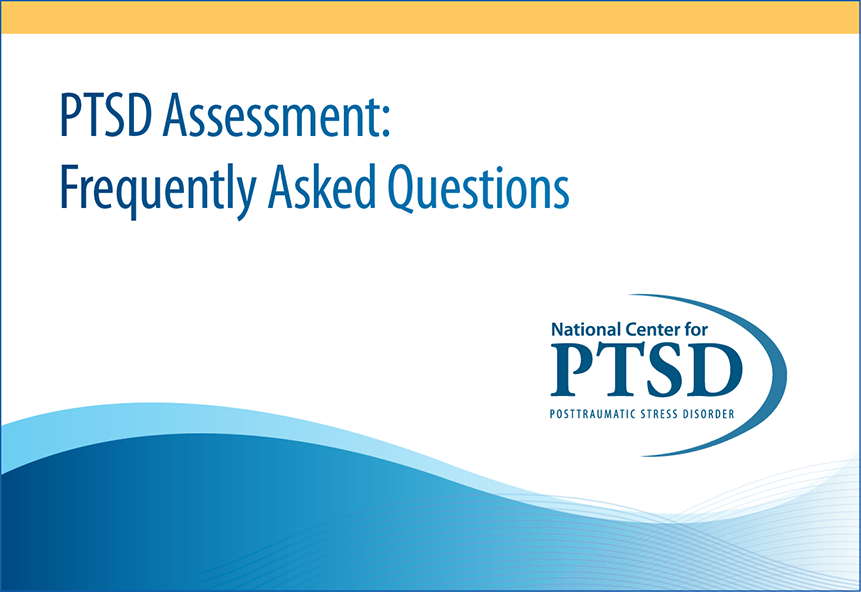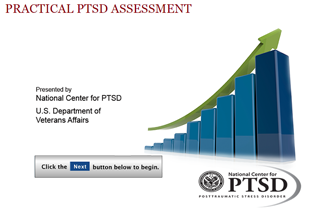PTSD: National Center for PTSD
FAQs about PTSD Assessment: For Professionals
FAQs about PTSD Assessment: For Professionals
Accurate and comprehensive PTSD assessment is essential to understanding a patient's clinical presentation and to supporting engagement with and delivery of evidence-based treatment. Below are research-based responses to common questions providers have raised related to PTSD assessment. Each assessment page on our site includes citations that offer valuable information specific to that measure.
CONTINUING EDUCATION
PTSD Assessment: Frequently Asked Questions
This online course discusses common questions about PTSD diagnosis and assessments, offering information and resources to support assessing and treating Veterans and others with PTSD.
What is the difference between a trauma exposure measure and a PTSD measure?
The purpose of a trauma exposure measure is to identify what traumatic events an individual has experienced; the purpose of a PTSD measure is to determine whether the person has PTSD symptoms related to one of the identified events.
There are a variety of trauma exposure measures. Some are very broad and assess a range of negative life events as well as traumatic experiences. Others have a narrower focus and only assess Diagnostic and Statistical Manual of Mental Disorders (DSM) Criterion A traumas that involve life threat.
Similarly, there are a range of PTSD measures that can be broad enough to include symptoms other than those related to PTSD. There are also PTSD measures that are more focused on the PTSD symptoms needed to make a diagnosis using the DSM. In most cases, a thorough PTSD assessment involves the use of both a broad measure and a more focused measure.
NOTE: PTSD co-occurs with a number of physical and/or mental health conditions more often than not. Be sure to see the Co-Occurring Conditions section for information to help with assessment.
What are the main differences among PTSD measures?
One of the most important differences among PTSD measures is in format. Measures range in number of items and by means of administration. For example, measures vary from a self-report with a single rating for each item to a structured interview with detailed inquiries about each symptom and interviewer ratings regarding the validity of reports. There are differences among structured interviews as well:
- Some interviews have a single gate-keeping item
- Interviews differ on the level of sophistication for assessing each PTSD symptom
- In some interviews, the ratings reflect symptom severity and/or frequency
Although interview measures require more interviewer training and administration time, they result in a more comprehensive assessment of PTSD.
What are the main differences among trauma exposure measures?
Trauma exposure measures differ in several ways:
- Length
- Range of trauma types assessed
- Degree of detailed inquiry about each traumatic event
Many measures simply assess exposure to high-magnitude stressors that could cause traumatic stress. Others have detailed questions to follow up endorsed events. For example, one measure may have detailed questions about certain elements of an interpersonal violence experience, while another measure may only require a 'yes' or 'no' as to whether the person was exposed to a particular type of interpersonal violence.
Some measures have been better validated than other measures. Also, some differ as to whether they assess emotional responses to the stressor.
What is the best measure for assessing PTSD symptoms?
Although we are frequently asked this question, there is no one 'best' PTSD measure. The right measure for a particular purpose depends on your goal. If you want a quick screen, a self-report measure may be best. However, if you are conducting a PTSD treatment study, you may want a sensitive interview that assesses for frequency and severity of symptoms.
Some important considerations in choosing a PTSD measure include:
- Time required to administer the measure
- Reading level of the population being sampled
- Whether you need to assess symptoms related to a single traumatic event or to assess symptoms related to multiple traumatic events (or to assess symptoms when the trauma history is unknown)
- Whether the measure needs to correspond to DSM criteria for PTSD
- Psychometric strengths and weaknesses of the measure
- Cost of using the measure
- Whether complexity and language of the measure is appropriate to the population being sampled
For making a diagnosis of PTSD rather than simply assessing symptoms, structured interviews will generally yield more valid results than other types of measures. An exception is that structured interviews that begin with a single gate-keeping item have poor validity for particular types of traumatic experiences. Also, structured interviews with brief, single-item, closed-ended questions for each PTSD symptom are likely to be no more valid for making a diagnosis than self-report measures.
Lastly, the validity of a structured interview will be greatly affected by the level of training of the interviewer. If interviewers do not have specific training in mental disorders, clinical assessment, traumatic stress, and administration of the particular structured interview being used, results of the interview may be invalid. Brief scales and self-report measures cannot be used to establish a diagnosis of PTSD because there is too much chance for error in responses.
CONTINUING EDUCATION
Practical Assessment of PTSD
This course provides a practical guide for assessing PTSD. The purpose and importance of screening for PTSD and monitoring symptom change and treatment outcomes are addressed.
How do I determine the forensic validity of a PTSD diagnosis?
Proper assessment of PTSD is complex, and in a forensic setting, it should include substantial attention to corroboration of self-reports and collateral information. Forensic assessment for PTSD requires comprehensive diagnosis by a qualified clinician using standardized valid assessment measures. It is also recommended that independent validation of assessment reports and measurement of psychophysiological responses to memories of traumatic events are included, when possible (1).
It is of critical importance for courts to understand that the development and experience of PTSD is not universal. PTSD can develop from a variety of traumatic events that contribute to unique pathways and outcomes of the disorder (2). Therefore, generalizing a singular experience of PTSD or standard prognosis marked by a diagnostic label is not accurate.
In cases where secondary gain is suspected, tests of malingering are warranted in conjunction with the corroboration of the PTSD diagnosis. In the absence of a definitive test for malingering, some recommend that courts understand the potential benefit in misrepresentation, critically evaluate diagnostic and functional history of the individual, and obtain collateral information, as mentioned above (3).
How do I choose a measure to assess trauma history?
It is difficult to assess trauma history because researchers cannot firmly establish the validity of trauma-exposure measures. It is so difficult to determine whether trauma reports are accurate that the validity of even the best measures has not been very rigorously studied. That being said, it seems likely that most trauma-exposure assessments will have some validity, and their clinical relevance makes them necessary.
In choosing a measure of trauma history or exposure, there is generally a trade-off between the specificity of the assessed traumatic events and the length of the assessments.
- Measures that query about the widest range of potentially traumatic events, and presumably yield the most accurate reports, will be the longest.
- Measures that are quick and easy will inquire very broadly about types of events and may miss idiosyncratic traumatic events.
Thus, in choosing a trauma-exposure measure for research, investigators will typically need to weigh the need for a detailed trauma-exposure assessment against the time limitations for the administration. Another consideration is whether the researcher is more interested in data regarding exposure to potentially traumatic (or high-magnitude) stressors or regarding exposures that resulted in significant emotional responses. Only a few measures assess the nature, degree, and duration of emotional responses to the stressor.
How can I obtain trauma exposure and PTSD assessment measures?
The American Psychological Association's ethical guidelines on psychological test instruments require advanced graduate-level training in the administration and interpretation of psycho-diagnostic assessment instruments.
Thus, we are not able to distribute measures to people who do not hold at least a master's degree in a clinical discipline. Graduate students must have a professor request the measure for them and use the measure under the professor's supervision.
In the Assessment Overview, you will find additional information about many PTSD and trauma exposure measures as well as best practices for evaluation.
We provide information on a variety of measures assessing trauma and PTSD. These measures are intended for use by qualified mental health professionals and researchers. Measures authored by National Center staff are available as direct downloads or by request. Measures developed outside of the National Center can be requested via contact information available on the information page for the specific measure. See a list of all measures.
References
- McGuire, J., & Clark, S. (2011). PTSD and the law: An update PTSD Research Quarterly, 22(1). Retrieved from https://www.ptsd.va.gov/publications/rq_docs/v22n1.pdf
- Young, G., & Yehuda, R. (2006). Understanding PTSD: Implications for court. In G. Young, A.W. Kane, & K. Nicholson (Eds.), Psychological knowledge in court: PTSD, pain, and TBI (pp. 55-69). Springer.
- Hall, R. C., & Hall, R. C. W. (2007). Detection of malingered PTSD: An overview of clinical, psychometric, and physiological assessment: Where do we stand? Journal of Forensic Sciences, 52, 717-725. https://doi.org/10.1111/j.1556-4029.2007.00434.x

























